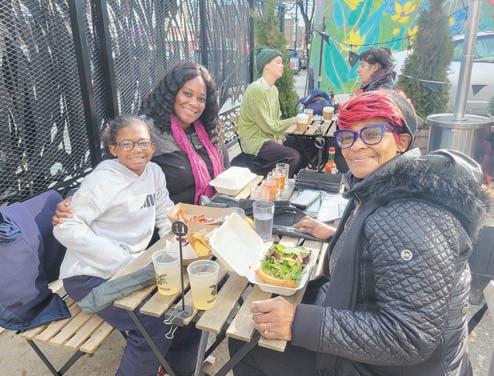
9 minute read
Rediscovering Pennsylvania’s signature drink
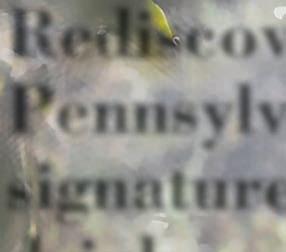
Changes in state and federal policies have made it possible for local growers to make and market their own hard cider
Advertisement
By CARLA ROBINSON
When Matt and Kim Vendeville open Cider Belly, an intimate cafe they say will give the same kind of sophisticated treatment to Hard Cider that most people associate with wine, they’ll be bringing more than just Philadelphia’s newest taproom to Chestnut Hill.
The newlyweds, who plan to open in December, are also a living example of why state policies really matter when it comes to homegrown industries like this one – and how flexibility and smart thinking by lawmakers can really pay off. Their taproom, and indeed their whole entrepreneurial journey thus far, would not have been possible without two recent changes to state and federal laws: the 2018 Cider Act, which gave hard cider its own federal legal status, and the 2019 decision by Pennsylvania’s state legislature to give in-state cider makers the right to produce and sell with the same licenses used by beer and wine makers.
“Being able to start under someone else’s license, and also to use their equipment and their space, is really what made it all possible for us,” Matt said. “That was like our pilot. It’s how we were able to get proof for our concept, raise some money and get into a position where we could secure the funding we need to really move forward.”
Ben Wenk, president of the Pennsylvania Cider Guild, who produces his Ploughman Farm Cider on the family farm in Adams County, said he’s seen a similar pattern play out all over the state.
“It’s been an incredible step forward for small independent producers – really a game-changer,” he said. “Those of us who have worked to make this happen are also hopeful that other family-owned orchards will see this as a viable way to keep their farms in agriculture. My own personal goal, as the owner of a family farm, is that this will spur economic development and preserve green space at the same time, all while supporting healthy and vibrant rural communities.”
Doubling the market
Industry data suggest that it’s working. According to the blog Cider Guide, run by selfstyled cider expert Eric West, the number of producers in Pennsylvania has doubled over the past three to four years – increasing from 24 to 58 statewide. And according to Wenk, membership in the Pennsylvania Cider Guild, which he founded to push for recent changes to state law, has also doubled.
“Even through the pandemic, we’re seeing more and more producers coming online,” Wenk said. “In Philadelphia specifically, we’re not just seeing new producers, we also see a new demand for the product. Our own sales in Philadelphia are growing at a really healthy rate.”
Case in point: Cider Belly is the second craft cidery to open in the Northwest Philadelphia region in the past two years, and a third is on the way.
Young American Hard Cider & Tasting Room opened its doors on Germantown Avenue in
2020 in the middle of the pandemic, just across the line from Mt. Airy into Germantown. And further west, Dressler Estate will soon be following suit – with a new Downingtown taproom scheduled to open in July.
“This industry is definitely expanding, and that’s a good thing – because the more people who are exposed to a good hard cider, the more they’ll like it, and the more demand will grow,” said Kate Kaman, Young American’s co-owner and head cider maker.
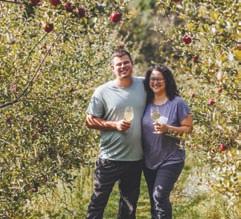
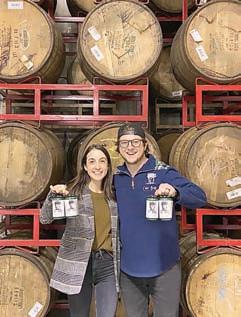
According to Kaman, there is such a taste difference between the small batch ciders made by small producers and the commercially produced big brands that customers really need to try it before they’re convinced.
“The key is, it’s got to be made from fresh local apples,” she said, adding that they buy theirs from Solebury Orchards in New Hope. “Large scale cideries that ship all over the country can’t really use fresh juice, so they depend on concentrate, which produces a completely different taste. It just doesn’t have the complexity, depth and nuance that fresh cider, properly aged and kept in the right conditions, can have.”
Brian and Olga Dressler are coming up next. Their label, Dressler Estate, is planning to open a new taproom in July.
These two, who met while he was studying mechanical engineering at Drexel University and she was studying photography at Temple’s Tyler School of Art, left the city for Downingtown six years ago just so that they could eventually grow their own apples.
“Pennsylvania has a great climate, and soil, for apples,” said Dressler, who now has an acre under cultivation. “In fact, some people say it’s better for apples than it is for grapes.”
They’ve been selling their cider directly from their production facility in Downingtown, at the Phoenixville and Rittenhouse Square farmers markets and also at the one in Chestnut Hill, where they set up shop on the third Saturday of every month. And business has been good – good enough to start planning their own taproom.
“We’re planning to open right on Lancaster Avenue, and our focus will be our ciders but also other locally produced food and drink,” Brian Dressler said. “We’ll be pouring not just our own ciders but other locally made drinks as well, including beers and wines, and we’ll also have a local focus with our food.”
Dressler Estate ciders, like the other two new producers in the northwest region, tend toward being dry, with a light and crisp palate. These cider makers don’t typically add sugar to the juice, and they wind up hitting the tongue much like a dry white wine.
A festival says you’re succeeding
One of the most telling, if unscientific, ways to measure whether a product is gaining traction is whether or not it gets a festival. In the case of Philadelphia, that happened about five years ago, when Amy Hartranft co-founded Philly Cider Week. She was working as a Center City bartender at the time, and noticed how many people were starting to ask for cider.
“We threw a couple of cider events in 2017 and everything we had sold out. That’s what made us realize that this was an untapped market,” she said. And, with the exception of a forced interruption due to COVID, the festival has been growing ever since.
“This year, the traction on my website has exponentially increased from even just last year,” she said. “There’s been a significant uptick in interest in both urban cideries, where people buy the juice and ferment it on their own site, and orchard- based cideries, where people often grow their own apples.”
Mulled Cider
Makes 8-10 drinks
1 1/2 liters (2 750ml bottles) of local craft cider
1 apple, quartered and studded with whole cloves
2-3 cinnamon sticks
4-5 allspice berries
2 cardamom pods
1-2 star anise
2-inch piece vanilla bean, split 1/4-1/2 teaspoon ground nutmeg
Juice of 1/2 orange
8-10 orange zest strips
4-6 ounces choice spirit (optional, see below)
Garnish: 1/2 cup cranberries, 8-10 apple slices, 8-10 orange peels
Combine ingredients in a large saucepan and simmer gently for 20-30 minutes, careful not to boil. Serve into individual glasses, teacups or mugs and garnish with 2-3 cranberries, an apple slice and orange peel.
If you want to give your mulled cider a “little boost,” add a little apple brandy, Calvados or even Applejack. Rum or whiskey can also be used.
In Chestnut Hill, Matt and Kim Vendeville are determined to keep up – and perhaps even raise the level of the game.
“We were inspired by our honeymoon travels, so we want our place to have an intimate and warm feeling, like something you’d find in a hidden alleyway in Europe – more like a wine bar meets coffee shop,” Kim said.
The couple, who met while pursuing their master’s degrees at the University of Pittsburgh, hers in healthcare administration and his in public health and infectious disease, acquired their taste for dry, small-batch cider while living in that college town. But it wasn’t until they took their wedding trip to England, France and Ireland that it occurred to them that they could make their own.
Upon their return home, they, like many be-
Crisp, light and tart — wait, can that be a cider?
Hard cider, like wine, is made from fermented fruit – and produces just as much variety in taste and character.
Who knew, for example, that North America’s once ubiquitous cider apples, now virtually nonexistent, were so bitter to taste that no one could eat them? And that cider made with these apples can be so full of body that you almost feel that you’re eating it?
“Part of the battle in getting cider into more people’s hands is fixing the misconception that it’s just one thing – and usually that thing is something sweet,” said Amy Hartranft, director of Philly Cider Week, an annual cider festival she co-founded five years ago. “Cider comes in many flavors and taste profiles. And just like wine, much of the flavor will come down to nature – what year the apples were grown, and where, and whether it happened to be a rainy season.”
While you can make a good cider with all kinds of apples, local makers say the best choices tend ginners, started out making small batches in their garage. And by the time their new jobs brought them to Philadelphia in 2020, they had already “proved the concept.”
“Then we were like, ‘How do we make this a real business, and do it commercially?’” Matt said.
As soon as they learned that new state laws would allow them to produce and sell cider under another wine or beer producer’s existing license, Matt got busy.
“I sent emails to every winery within 20 miles, asking if they had a 10-by-10 space that we could rent or borrow,” he said.
Eventually, Cardinal Hollow Winery in Lansdale agreed to rent their license, their equipment, and some space. Now, a year later, Cider Belly has sold out every batch they’ve made, and the couple is ready to open their own shop.
Local, local, local….
Like Young American and Dressler Estate, Cider Belly intends to focus on local products. “We want everything to be hyper local –we’re aiming to have everything on our menu be something that’s produced within a 40-mile radius,” Kim said.
That includes their glass carafes, which will be hand blown by a local glassblower, and also their plates, hand thrown by a family member.
“Our bread is literally going to come from next door,” Matt said, referring to the fact that their taproom will be located just steps away from Baker Street Bread Company. And they buy their apples from Beekman Orchard in Boyertown, which is a 38-mile drive.
“They’re a family-owned farm that’s been around 70 years,” Kim said. “They’re the sweetest people you could ever meet.”
Their intense focus on local products, made by people they know and have relationships with, is critical to their long-term plan.
“Cider’s obviously what brought us here, and is why we’re doing all of this, but taking it full circle, what we bonded over was this entrepreneurial idea, and the kind of lifestyle we wanted to live,” Kim said. “So cider is the vehicle. We want to produce a great product, but we also want to wrap that around this awesome experience, an expression of how we want to live.” to be sharp. A sharp apple, properly fermented and aged, can produce a drink every bit as dry as a crisp Sauvignon Blanc.
“The best apples for cider are bittersweet and bitter sharp, because of the tannins,” said Ben Wenk, president of the Pennsylvania Cider Guild.
The old-fashioned cider apples, so bitter they can’t be eaten, “produce a beverage with more body, and a full-mouth experience,” he said. “They tend to have a deeper amber color, they can age longer, and they give you that cat’s tongue fuzziness that you can get with a rich red wine.”
Kim Vandeville, who is about to open Northwest Philadelphia’s newest taproom, Cider Belly, said her sister may have put it best. “When she came to visit and I gave her a glass, she said ‘Oh my gosh it tastes like I’m eating blue cheese’.”
With the resurgence of interest in craft cider making, some local farmers are responding by bringing back some of the old cider varieties – and planting a handful of acres with apples nobody would ever want to bite into.
“While you can make good cider with any apple, there are certain types of cider that require these special apples,” Wenk said. “But it’s tough on the farmer, because you can’t use those for anything other than cider. Nobody is going to want to eat applesauce made out of those.”
On the other end of the spectrum, pears – with their light and delicate sweetness – produce a very light beverage that lands on the tongue more like wine. While it’s in the cider family, that drink gets its own name: Perry.
“Perry is super hard to make,” said Matt, who added that he and Kim intend to make it at Cider Belly. “Super hard to do. Finicky. But delicious.”
According to the legal definition recently enacted into federal law, hard cider is a fermented beverage made of apples or pears that contains up to 8.5 percent alcohol by volume. The alcohol is a by-product of the fermentation process, during which time sugar is broken down into ethanol and carbon dioxide. So the longer the mixture ferments, the more alcohol it has and the dryer the taste becomes.
If demand for this beverage keeps growing, the industry could do a lot to keep local farmers in business. It takes about a pound of apples to produce 12 ounces of cider – which adds up to roughly about three apples per drink.
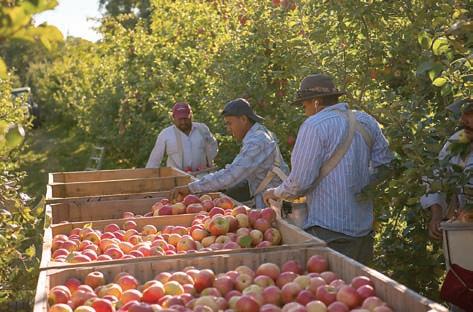
Remember that, next time you pony up to a cider bar!
— Carla Robinson








